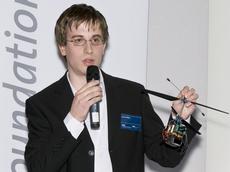High-flying ETH Zurich does the double
Last week, two teams of ETH Zurich took part in the “European Micro Aerial Vehicle Conference and Flight Competition” in South Holland. The air navigation competition was dominated by ETH Zurich expertise: the PIXHAWK and EMAVERICK teams fought a neck-and-neck race for the first place in the most prestigious discipline.

The “European Micro Aerial Vehicle Conference and Flight Competition” (EMAV) took place in Delft in the Netherlands last week. Besides interesting scientific lectures and presentations, the event’s main attraction was the flying competition in which unmanned aircraft competed against one another in four disciplines. Because each of the individual disciplines required different abilities of the aircraft, most of the contestants – including the two ETH Zurich teams – focused on only one discipline. The Zurich micro-helicopters were victorious in the “Indoor Autonomy Mission”: the PIXHAWK team won just ahead of the EMAVERICK team with a clear points lead on the other five contestants.
From a joint project
The EMAVERICK project was launched at the Autonomous Systems Lab (ASL) of the Department of Mechanical and Process Engineering, led by post-doc Davide Scaramuzza, with two doctoral candidates and four students participating. In contrast, PIXHAWK is a pure students’ project: led by computer science student Lorenz Meier, Master and Bachelor students of computer science, electrical engineering and mechanical engineering worked together on the victorious project in the Computer Science Department’s Computer Vision and Geometry Lab (CVG). Marc Pollefeys, Professor of Visual Computing and Head of the CVG, together with Dr. Friedrich Fraundorfer, post-doc at the CVG, were on hand to advise them.
While the two projects that won ETH Zurich the double were developed completely independently of each other in two different ETH Zurich departments, there is ongoing cooperation in this area due to a common research project: the ASL and the CVG are collaborating closely in the international sFly project. Roland Siegwart, Professor of Autonomous Systems and Head of the ASL, and Marc Pollefeys both stress that “this is why there is also a lively exchange between the two project teams.”
Preparation and development took about six months, and the commitment rapidly became a full-time job for many of those involved. Even several days after the competition, there are still piles of instant coffee cups and soup packets in the PIXHAWK team’s workshop. The fact that 25-year-old Lorenz Meier was able to make such a commitment is thanks to his Excellence Scholarship. Private individuals, foundations and companies fund talented Master students through these scholarships to allow them to concentrate on promising research projects.
A different approach, a different strength
Meier thinks that the “Indoor Autonomy Mission”, in which aircraft had to navigate in a building and recognise a picture on the wall, was the most demanding and prestigious discipline “because the focus there was on autonomous, GPS-independent navigation, not on speed or endurance.” Whereas fully autonomous navigation, in which the aircraft finds its way independently of a remote controller, was the EMAVERICK team’s showpiece discipline in the competition, PIXHAWK scored points mainly in visual object recognition.
As well as these technological focuses, the constructions of the two aircraft also differ. PIXHAWK were the only entrants in the competitive field with a coaxial helicopter. This has two horizontal rotors turning in opposite directions one above the other on the same axis, thus balancing out the gyration and increasing stability. The other teams relied on quadrotor helicopters, which are driven by four horizontal rotors in a quadratic setup. The coaxial helicopter has two decisive advantages: “Firstly, at 500 grams, it is 20 to 40 percent lighter than the competition, and, secondly, we have a smaller overall diameter, which had a positive input into the assessment”, project leader Lorenz Meier says.
Not many points separated the two ETH Zurich teams at the end. “It was close”, stresses Meier. The competition’s ranking list confirms that ETH Zurich occupies a leading role in the fields of autonomous navigation and visual computing.







READER COMMENTS